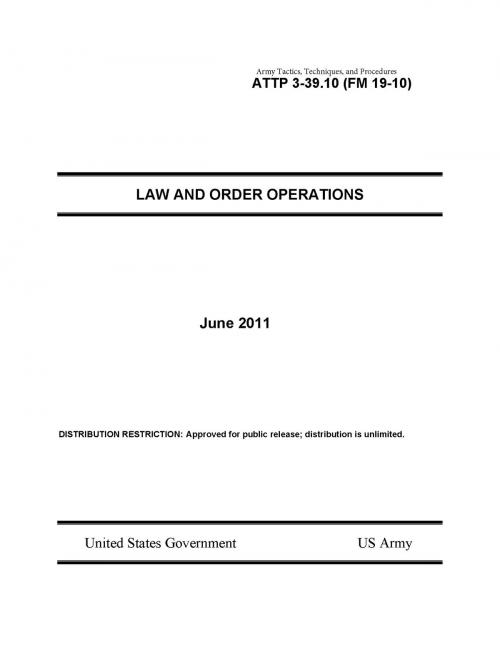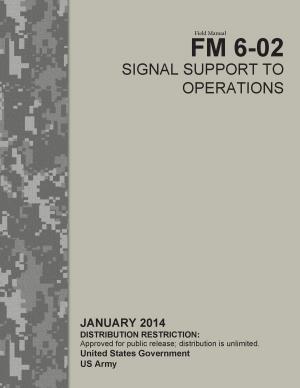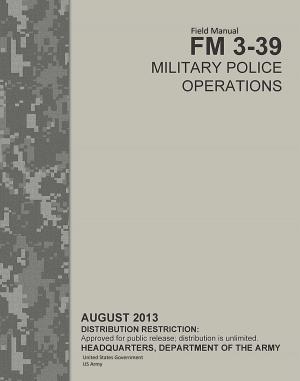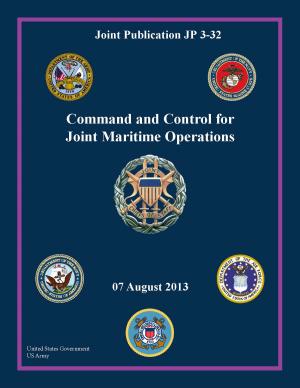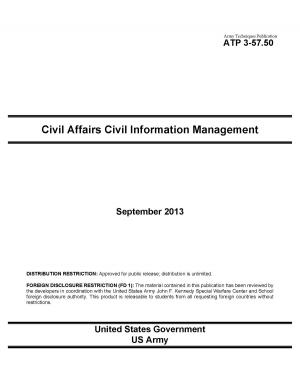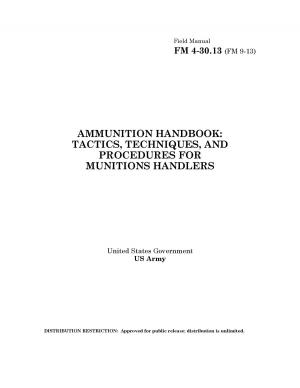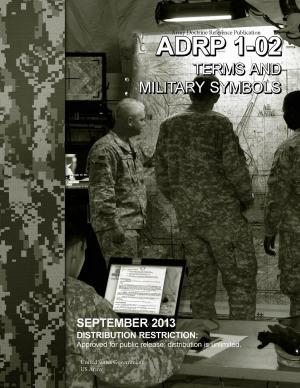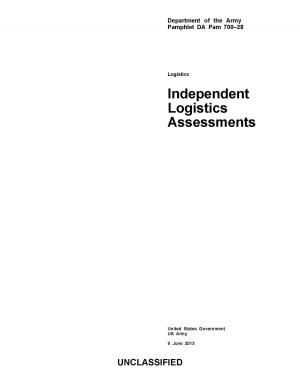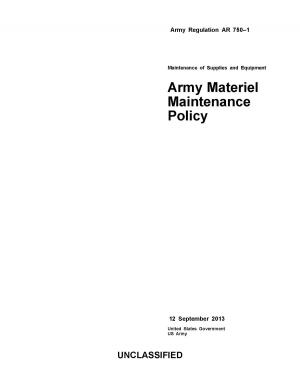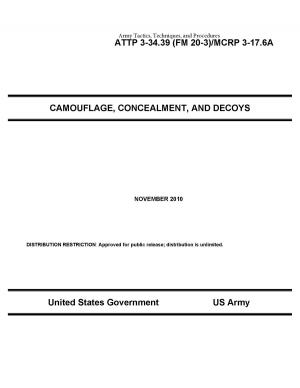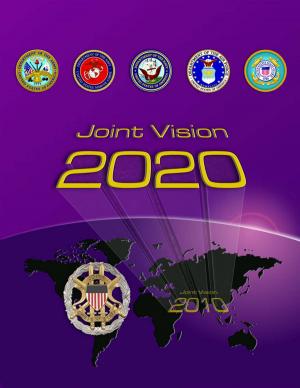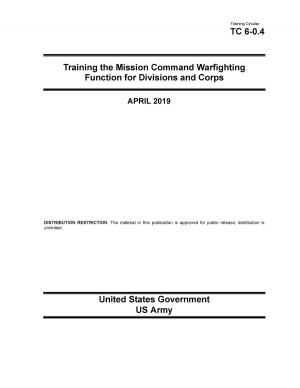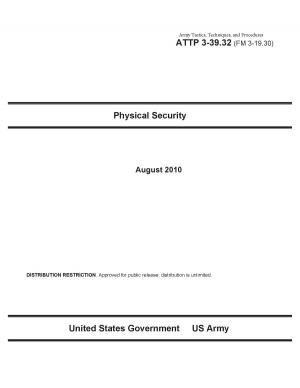Army Tactics, Techniques, and Procedures ATTP 3-39.10 (FM 19-10) Law and Order Operations
Nonfiction, Reference & Language, Law, Military, Criminal Procedure, Criminal law| Author: | United States Government US Army | ISBN: | 1230000126188 |
| Publisher: | eBook Publishing Team | Publication: | April 20, 2013 |
| Imprint: | Language: | English |
| Author: | United States Government US Army |
| ISBN: | 1230000126188 |
| Publisher: | eBook Publishing Team |
| Publication: | April 20, 2013 |
| Imprint: | |
| Language: | English |
ATTP 3-39.10 is written for Army military police personnel conducting L&O operations while assigned to military police brigades, battalions, companies, detachments, U.S. Army Criminal Investigations Command (USACIDC) elements, military police platoons organic to brigade combat teams (BCTs), and provost marshal (PM) staffs. It applies to military police commanders, staff, functional cells, and multifunctional commanders and staff elements at all echelons tasked with planning and directing policing and LE operations.
This manual is organized into seven chapters with eight appendixes to provide additional details on selected operational topics. The first two chapters describe L&O aspects of the OE and the planning and integration of L&O operations in support of full spectrum operations. The remaining chapters discuss LE operations, police engagement, and host nation (HN) police training and support. A brief description of each chapter and appendix is provided below:
• Chapter 1 describes the OE, with particular focus on the nature and scope of modern conflict and the relevance of L&O operations within the OE. It provides key definitions and the doctrinal framework for L&O operations that provide understanding and focus for policing and LE activities.
• Chapter 2 provides considerations for planning and conducting L&O operations. The chapter includes a discussion of the policing principles, the various policing models and strategies, and the relationship between LE and due process.
• Chapter 3 discusses the mission command of L&O operations. It focuses on police station operations and the relevance of the police station to the command and control of police assets and the management of police information and specific LE activities and requirements.
• Chapter 4 describes LE patrol operations, including discussions of patrol methods and strategies, interviews and LE interrogations as they apply to basic LE patrols, search and seizure procedures, and basic report writing.
• Chapter 5 focuses on police engagement. This chapter discusses police engagement as a policing and LE-specific application of activities to inform and influence. It describes police engagement planning and coordination considerations; specific police engagement activities; and the use of forums, working groups, and boards to facilitate police engagements.
• Chapter 6 describes traffic operations, as conducted within the L&O function, and includes a limited discussion on traffic-related tasks conducted within the context of maneuver and mobility support (MMS) operations. It discusses traffic planning, traffic control and enforcement, traffic accident investigations, and traffic assessments.
• Chapter 7 discusses building police capability and capacity. This chapter includes a discussion of HN police support and the restoration of civil control: the reconstitution of HN police forces, training of HN forces, mission command of military police elements conducting HN police training and support, and sustainment of HN police forces.
• Appendix A provides information on authority and jurisdiction in conducting LE operations.
• Appendix B describes basic police station construction requirements.
• Appendix C addresses basic evidence collection guidelines and provides a doctrinal framework describing evidence collection and forensic analysis.
• Appendix D focuses on customs and border control support by Army military police.
• Appendix E discusses methods for calculating LE patrol and manpower requirements.
• Appendix F focuses on crime prevention programs and strategies.
• Appendix G provides basic planning considerations for L&O-related equipment requirements.
• Appendix H describes considerations for special-response situations.
ATTP 3-39.10 provides the operational architecture and guidance for military police commanders and trainers at all echelons for the integration and instruction of L&O operations in established curriculum within the Army’s education system.
ATTP 3-39.10 is written for Army military police personnel conducting L&O operations while assigned to military police brigades, battalions, companies, detachments, U.S. Army Criminal Investigations Command (USACIDC) elements, military police platoons organic to brigade combat teams (BCTs), and provost marshal (PM) staffs. It applies to military police commanders, staff, functional cells, and multifunctional commanders and staff elements at all echelons tasked with planning and directing policing and LE operations.
This manual is organized into seven chapters with eight appendixes to provide additional details on selected operational topics. The first two chapters describe L&O aspects of the OE and the planning and integration of L&O operations in support of full spectrum operations. The remaining chapters discuss LE operations, police engagement, and host nation (HN) police training and support. A brief description of each chapter and appendix is provided below:
• Chapter 1 describes the OE, with particular focus on the nature and scope of modern conflict and the relevance of L&O operations within the OE. It provides key definitions and the doctrinal framework for L&O operations that provide understanding and focus for policing and LE activities.
• Chapter 2 provides considerations for planning and conducting L&O operations. The chapter includes a discussion of the policing principles, the various policing models and strategies, and the relationship between LE and due process.
• Chapter 3 discusses the mission command of L&O operations. It focuses on police station operations and the relevance of the police station to the command and control of police assets and the management of police information and specific LE activities and requirements.
• Chapter 4 describes LE patrol operations, including discussions of patrol methods and strategies, interviews and LE interrogations as they apply to basic LE patrols, search and seizure procedures, and basic report writing.
• Chapter 5 focuses on police engagement. This chapter discusses police engagement as a policing and LE-specific application of activities to inform and influence. It describes police engagement planning and coordination considerations; specific police engagement activities; and the use of forums, working groups, and boards to facilitate police engagements.
• Chapter 6 describes traffic operations, as conducted within the L&O function, and includes a limited discussion on traffic-related tasks conducted within the context of maneuver and mobility support (MMS) operations. It discusses traffic planning, traffic control and enforcement, traffic accident investigations, and traffic assessments.
• Chapter 7 discusses building police capability and capacity. This chapter includes a discussion of HN police support and the restoration of civil control: the reconstitution of HN police forces, training of HN forces, mission command of military police elements conducting HN police training and support, and sustainment of HN police forces.
• Appendix A provides information on authority and jurisdiction in conducting LE operations.
• Appendix B describes basic police station construction requirements.
• Appendix C addresses basic evidence collection guidelines and provides a doctrinal framework describing evidence collection and forensic analysis.
• Appendix D focuses on customs and border control support by Army military police.
• Appendix E discusses methods for calculating LE patrol and manpower requirements.
• Appendix F focuses on crime prevention programs and strategies.
• Appendix G provides basic planning considerations for L&O-related equipment requirements.
• Appendix H describes considerations for special-response situations.
ATTP 3-39.10 provides the operational architecture and guidance for military police commanders and trainers at all echelons for the integration and instruction of L&O operations in established curriculum within the Army’s education system.
